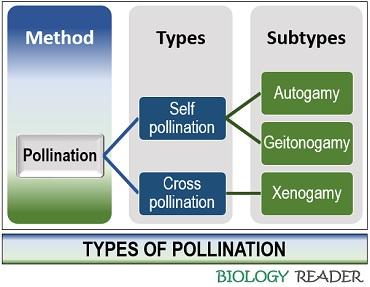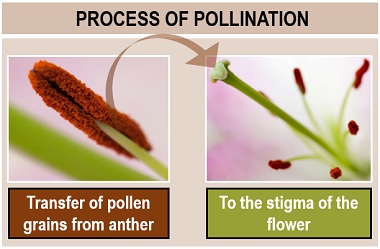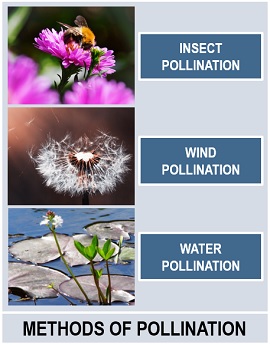Pollination in a flower is a transferring mechanism of pollen grains from the anther (flower’s male reproductory part or stamen) to the stigma (flower’s female reproductive part or gynoecium). It is the primary stage that results in the flower’s fertilization. The passage of pollen grains from an anther to a stigma occurs via pollinating agents or pollinators.
The pollinators can be the biotic or abiotic agents that initiate the pollination process. Once the pollen grains stick to the platform of stigma, they start germinating. A pollen tube forms during pollen germination spans within the long flower’s style and eventually penetrates the embryo sac.
Once the pollen grain reaches the embryo sac, it fuses with the female gametes or ovules to promote fertilization. In this context, we will study the definition, two major types, the process of pollination as well as the pollinating agents.
Content: Pollination in Flower
Definition of Pollination
Pollination merely refers to the process before the flower’s fertilization, which involves the shedding of pollen grains from an anther to the stigma. It may occur within the plant of the same flower, different species of the same flower or the different flowers.

Pollinators serve as the carriers, which facilitate pollination. Generally, the gametes of a flower are non-motile, due to which a flower needs a pollinator to proceed with the growth process following pollination and fertilization. Pollination usually occurs via self and cross-pollination methods.
Types of Pollination in Flower
In flowers, pollination commonly involves the following two types:

Self Pollination in Flower
In this type, pollination occurs within the same flower or the different species of the same flower. It occurs in the same flower, which contains both the male and female sexual parts. Self-pollination usually occurs in hermaphrodite or dioecious plants, where a flower pollinates by itself or less dependent on external factors. It commonly occurs in two ways:
- Autogamy: It is a type of self-pollination where pollination occurs within the same flower. It is sporadic but requires the anther and stigma to lie close to each other. During autogamy, there must be synchronisation between the pollen release from an anther and stigma receptivity. Chasmogamous and cleistogamous flowers are examples.
- Geitonogamy: It is the condition where pollination occurs between the different flowers of the same plant. Geitonogamy is considered a type of self-pollination that occurs in the same flower. However, this method requires a vector or external agents.
Advantages of Self-pollination:
- Self-pollination gives rise to genetically similar genes in flower.
- Eliminates recessive characters from a plant.
- It does not strongly depend upon the pollinating agents.
- Self-pollination reduces the loss of pollen grains.
Disadvantages of Self-pollination:
- Self-pollination does not result in the evolution of new characters.
- A plant is less resistant to environmental stresses and diseases.
Cross Pollination in Flower
In this type, pollination occurs within the two different flowers of different origin, i.e. pollen of one flower disperses over another flower’s stigma. This pollination gives rise to genetically different flowers. Cross-pollination always requires a vector or an agent to carry out the pollination. “Xenogamy” is a type of cross-pollination.
Advantages of Cross-pollination:
- Cross-pollination gives rise to the evolution of new characters to a flower.
- Provides resistance to the plant against environmental stresses and various diseases.
- Helps in the reproduction of a unisexual plant.
Disadvantages of Cross-pollination:
- Cross-pollination results in a loss of pollen grains.
- There may get some chances that unwanted characteristics incorporate into a flower.
- Strongly depends upon external factors like wind, water and insects for pollination.
Pollination Process
The process of pollination includes the following steps:

- Shedding of pollen grains onto the platform of stigma.
- On favourable conditions, pollen grains germinate and form a germ tube or pollen tube.
- Then, the pollen tube moves downwards from the stigma to the pistil, along with the sperm cells.
- The pollen tube comes in contact with the wall of the embryo sac and penetrates it.
- Finally, the sperm cell fuses with the egg cells to bring out the fertilization process.
Agents of Pollination
As we have discussed earlier that the pollinators mediate pollination, which are of two kinds.
- Abiotic agent
- Biotic agent
The abiotic agent includes wind and water, whereas the biotic agent includes insect vectors to carry out the pollination process.

Insect Pollination
It is the most common pollination method, which involves a range of insects like bees, butterflies, and beetles as vectors that facilitate pollination in the majority of flowers. Bee dominates among the other insect vectors.
The pollen transfer by an insect vector is a mechanism that refers to the “Entomophilous pollen”. Insect pollination imparts the following characteristics to the flowers :
- Insect pollinated flower is large and colourful.
- Produces a sugary fluid or nectar that attracts the insects.
- Flowers produce sticky pollens and stigma as a result of insect pollination.
- The flower’s anther and stigma are firmly attached to the thalamus.
In insect pollination, the insects come in contact with the sticky pollen grains in search of nectar. The pollen grains stick to the insect, and when it sits on another flower, it rubs the pollen grains over the platform of sticky stigma.
Wind Pollination
There are certain conditions for wind pollination to occur:
- The pollen grains should be light and non-sticky.
- An anther should be exposed outside so that the dispersal of pollen grains by the wind currents become easy.
- Stigma is usually feathery, which traps the airborne pollen grains.
Wind pollination gives rise to a flower with a single ovule in each ovary. A wind pollinated flower lacks nectar and produce pollen in large quantities. The act of pollen transfer by an insect vector merely refers to the “Anemophilous pollen”. A flower pollinated by wind current has a dangled out anther and stigma. It commonly occurs in grasses.
Water Pollination
Water pollination occurs very rarely. It is limited only to the 30 genera of monocotyledons. It occurs mostly in aquatic plants like Vallisneria, Hydrilla and Zostera etc. In water pollination, the male anther sheds its pollen grains on the water surface. Some of the pollen grains reach the female’s stigma by the passive water current.
In seagrasses, both the male gametes (pollen grains) and the female flower remains inside the water. Thus, the pollen grain reaches the flower’s stigma in the form of long, ribbon-like pollen grains by the passive water current. Water pollinated flowers are:
- The flowers are usually dull in colour.
- Water pollinated flower consists of pollen grains that are protected by the mucilaginous covering.
- A flower lacks nectar.
Therefore, the above three agents, viz insects, wind, and water, accomplish pollination.